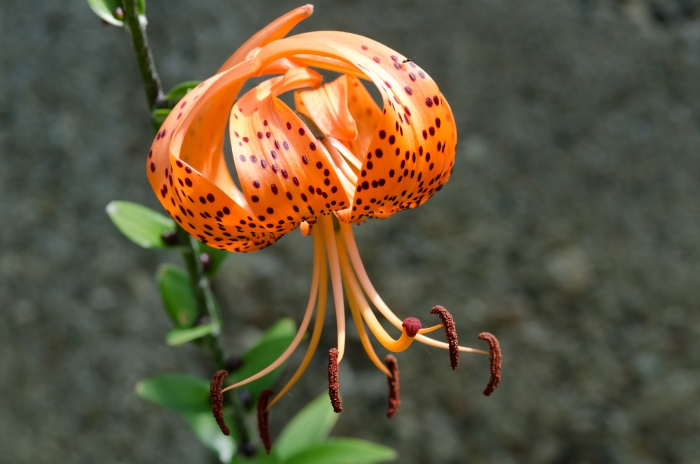Tiger Lily
(Lilium lancifolium)
Tiger Lily (Lilium lancifolium)
/
/

Amada44
CC BY-SA 3.0
Image By:
Amada44
Recorded By:
Copyright:
CC BY-SA 3.0
Copyright Notice:
Photo by: Amada44 | License Type: CC BY-SA 3.0 | License URL: https://creativecommons.org/licenses/by-sa/3.0 | Uploader: Amada44 | Publisher: Wikimedia Commons | Title: Lilium_lancifolium_7757.jpg |






























































Estimated Native Range
Summary
Lilium lancifolium, commonly known as Tiger Lily or Lance-Leaved Tiger Lily, is a deciduous perennial herb that is native to forest margins, grasslands, and wet meadows in East Asia, particularly China, Japan, and Korea. It typically grows to a height of 80–200 centimeters (31–79 inches) with upright stems and lance-shaped leaves. The plant is renowned for its striking flowers, which bloom in mid to late summer and are large, showy, and recurved with a vibrant orange color, speckled with dark spots. The flowers are unscented and form on long pedicels, adding to the plant’s ornamental value.
Tiger Lily is valued for its exotic-looking flowers and is often used in borders, cottage gardens, and naturalized areas. It is relatively easy to maintain and can be propagated by bulbils that form in leaf axils. In cultivation, it prefers full sun to part shade, well-drained soil, and moderate watering. While it can tolerate a range of soil types, it thrives in slightly acidic to neutral soils. Gardeners should be aware that Lilium lancifolium can be susceptible to lily beetle infestations and viral diseases. It is also known to be potentially invasive outside its native range, so it is important to consult local guidelines before planting.CC BY-SA 4.0
Tiger Lily is valued for its exotic-looking flowers and is often used in borders, cottage gardens, and naturalized areas. It is relatively easy to maintain and can be propagated by bulbils that form in leaf axils. In cultivation, it prefers full sun to part shade, well-drained soil, and moderate watering. While it can tolerate a range of soil types, it thrives in slightly acidic to neutral soils. Gardeners should be aware that Lilium lancifolium can be susceptible to lily beetle infestations and viral diseases. It is also known to be potentially invasive outside its native range, so it is important to consult local guidelines before planting.CC BY-SA 4.0
Plant Description
- Plant Type: Herb
- Height: 2-5 feet
- Width: 0.6-0.7 feet
- Growth Rate: Moderate
- Flower Color: Orange
- Flowering Season: Summer
- Leaf Retention: Deciduous
Growth Requirements
- Sun: Full Sun, Part Shade
- Water: Medium
- Drainage: Slow, Medium, Fast
Common Uses
Bee Garden, Bird Garden, Butterfly Garden, Deer Resistant, Hummingbird Garden, Low Maintenance, Showy Flowers
Natural Habitat
Native to forest margins, grasslands, and wet meadows in East Asia
Other Names
Common Names: Lance-Leaved Tiger Lily, Tiikerilija, Lis Tigré, Tigerlilje, Tigerlilja, True Tiger Lily, 참나리
Scientific Names: , Lilium lancifolium, Lilium tigrinum, Lilium lancifolium var. flaviflorum, Lilium tigrinum var. fortunei, Lilium lancifolium var. splendens, Lilium tigrinum var. splendens, Lilium lancifolium var. fortunei, Lilium lancifolium subsp. album, Lilium lancifolium subsp. melpomene
GBIF Accepted Name: Lilium lancifolium Thunb.